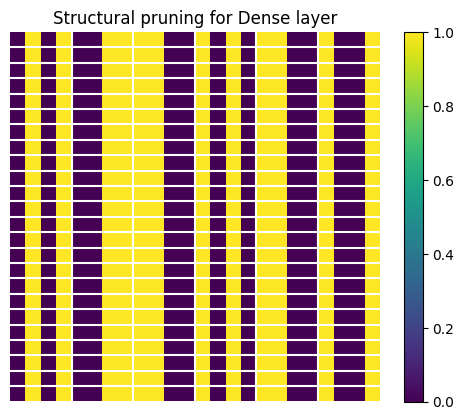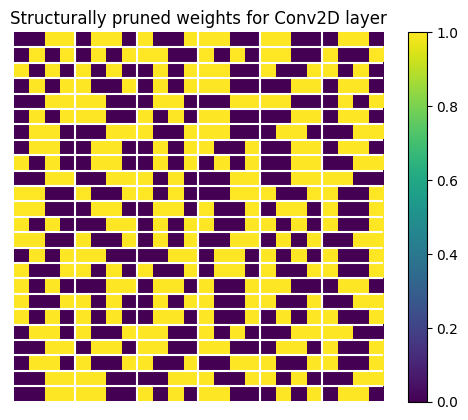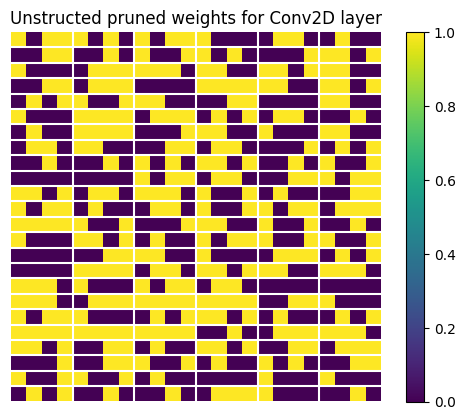Structural pruning weights from your model to make it sparse in specific pattern can accelerate model inference time with appropriate HW supports.
This tutorial shows you how to:
- Define and train a model on the mnist dataset with a specific structural sparsity
- Convert the pruned model to tflite format
- Visualize structure of the pruned weights
For a general overview of the pruning technique for the model optimization, see the pruning overview. For tutorial on general weight pruning, see Pruning in Keras.
Structural pruning of weights
Structural pruning systematically zeroes out model weights at the beginning of the training process. You apply this pruning techniques to regular blocks of weights to speed up inference on supporting HWs, for example: grouping weights in the model by blocks of four and zeroing out two of those weights in each block, known as a 2 by 4 reduction. This technique applies only to the last dimension of the weight tensor for the model that is converted by TensorFlow Lite. For example, Conv2D layer weights in TensorFlow Lite have the structure [channel_out, height, width, channel_in] and Dense layer weights have the structure [channel_out, channel_in]. The sparsity pattern is applied to the weights in the last dimension: channel_in.
Compare to the random sparsity, the structured sparsity generally has lower accuracy due to restrictive structure, however, it can reduce inference time significantly on the supported hardware.
Pruning can be applied to a model together with other model compression techniques for better compression rate. See quantization and clustering examples in collaborative optimization technique for more details.
Setup
Prepare your development environment and data.
pip install -q tensorflowpip install -q tensorflow-model-optimizationpip install -q matplotlib
import tensorflow as tf
from tensorflow import keras
import tensorflow_model_optimization as tfmot
prune_low_magnitude = tfmot.sparsity.keras.prune_low_magnitude
Download and normalize image data from the MNIST dataset
# Load MNIST dataset.
mnist = keras.datasets.mnist
(train_images, train_labels), (test_images, test_labels) = mnist.load_data()
# Normalize the input image so that each pixel value is between 0 and 1.
train_images = train_images / 255.0
test_images = test_images / 255.0
Define structural pruning parameters
Define parameters for pruning and specify the type of structural pruning. Set the parameters for pruning to (2, 4).
These settings mean that in a block of four elements, at least two with the lowest magnitude are set to zero.
You don't have to set the pruning_schedule parameter. By default, the pruning mask is defined at the first step and it is not updated during the training.
pruning_params_2_by_4 = {
'sparsity_m_by_n': (2, 4),
}
Define parameters for random pruning with the target sparsity of 50%.
pruning_params_sparsity_0_5 = {
'pruning_schedule': tfmot.sparsity.keras.ConstantSparsity(target_sparsity=0.5,
begin_step=0,
frequency=100)
}
Define the model architecture and specify which layers to prune. Structural pruning is applied based on the layers of the model you select.
In the example below, we prune only some of the layers. We prune the second Conv2D layer and the first Dense layer.
Notice that the first Conv2D layer cannot be pruned structurally. To be pruned structurally, it should have more than one input channels. Instead, we prune the first Conv2D layer with random pruning.
model = keras.Sequential([
prune_low_magnitude(
keras.layers.Conv2D(
32, 5, padding='same', activation='relu',
input_shape=(28, 28, 1),
name="pruning_sparsity_0_5"),
**pruning_params_sparsity_0_5),
keras.layers.MaxPooling2D((2, 2), (2, 2), padding='same'),
prune_low_magnitude(
keras.layers.Conv2D(
64, 5, padding='same',
name="structural_pruning"),
**pruning_params_2_by_4),
keras.layers.BatchNormalization(),
keras.layers.ReLU(),
keras.layers.MaxPooling2D((2, 2), (2, 2), padding='same'),
keras.layers.Flatten(),
prune_low_magnitude(
keras.layers.Dense(
1024, activation='relu',
name="structural_pruning_dense"),
**pruning_params_2_by_4),
keras.layers.Dropout(0.4),
keras.layers.Dense(10)
])
model.compile(optimizer='adam',
loss=keras.losses.SparseCategoricalCrossentropy(from_logits=True),
metrics=['accuracy'])
model.summary()
2024-03-09 12:19:11.497336: E external/local_xla/xla/stream_executor/cuda/cuda_driver.cc:282] failed call to cuInit: CUDA_ERROR_NO_DEVICE: no CUDA-capable device is detected
Model: "sequential"
_________________________________________________________________
Layer (type) Output Shape Param #
=================================================================
prune_low_magnitude_prunin (None, 28, 28, 32) 1634
g_sparsity_0_5 (PruneLowMa
gnitude)
max_pooling2d (MaxPooling2 (None, 14, 14, 32) 0
D)
prune_low_magnitude_struct (None, 14, 14, 64) 102466
ural_pruning (PruneLowMagn
itude)
batch_normalization (Batch (None, 14, 14, 64) 256
Normalization)
re_lu (ReLU) (None, 14, 14, 64) 0
max_pooling2d_1 (MaxPoolin (None, 7, 7, 64) 0
g2D)
flatten (Flatten) (None, 3136) 0
prune_low_magnitude_struct (None, 1024) 6423554
ural_pruning_dense (PruneL
owMagnitude)
dropout (Dropout) (None, 1024) 0
dense (Dense) (None, 10) 10250
=================================================================
Total params: 6538160 (24.94 MB)
Trainable params: 3274762 (12.49 MB)
Non-trainable params: 3263398 (12.45 MB)
_________________________________________________________________
Train and evaluate the model.
batch_size = 128
epochs = 2
model.fit(
train_images,
train_labels,
batch_size=batch_size,
epochs=epochs,
verbose=0,
callbacks=tfmot.sparsity.keras.UpdatePruningStep(),
validation_split=0.1)
_, pruned_model_accuracy = model.evaluate(test_images, test_labels, verbose=0)
print('Pruned test accuracy:', pruned_model_accuracy)
Pruned test accuracy: 0.9897000193595886
Remove the pruning wrapper so that it is not included in the model when you convert it to TensorFlow Lite format.
model = tfmot.sparsity.keras.strip_pruning(model)
Convert model to tflite format
import tempfile
converter = tf.lite.TFLiteConverter.from_keras_model(model)
tflite_model = converter.convert()
_, tflite_file = tempfile.mkstemp('.tflite')
print('Saved converted pruned model to:', tflite_file)
with open(tflite_file, 'wb') as f:
f.write(tflite_model)
INFO:tensorflow:Assets written to: /tmpfs/tmp/tmp04kvq4rj/assets INFO:tensorflow:Assets written to: /tmpfs/tmp/tmp04kvq4rj/assets Saved converted pruned model to: /tmpfs/tmp/tmp218fgsbq.tflite WARNING: All log messages before absl::InitializeLog() is called are written to STDERR W0000 00:00:1709986802.425001 13320 tf_tfl_flatbuffer_helpers.cc:390] Ignored output_format. W0000 00:00:1709986802.425052 13320 tf_tfl_flatbuffer_helpers.cc:393] Ignored drop_control_dependency.
Visualize and check weights
Now visualize the structure of weights in the Dense layer pruned with 2 by 4 sparsity. Extract the weights from the tflite file.
# Load tflite file with the created pruned model
interpreter = tf.lite.Interpreter(model_path=tflite_file, experimental_preserve_all_tensors=True)
interpreter.allocate_tensors()
details = interpreter.get_tensor_details()
# Weights of the dense layer that has been pruned.
tensor_name = 'structural_pruning_dense/MatMul'
detail = [x for x in details if tensor_name in x["name"]]
# We need the first layer.
tensor_data = interpreter.tensor(detail[0]["index"])()
To verify that we selected the correct layer that has been pruned, print the shape of the weight tensor.
print(f"Shape of Dense layer is {tensor_data.shape}")
Shape of Dense layer is (1, 1024)
Now we visualize the structure for a small subset of the weight tensor. The structure of the weight tensor is sparse in the last dimension, using the (2,4) pattern: two elements out of four are zeros. To make the visualization more clear, we replace all non-zero values with ones.
import matplotlib.pyplot as plt
import numpy as np
# The value 24 is chosen for convenience.
width = height = 24
subset_values_to_display = tensor_data[0:height, 0:width]
val_ones = np.ones([height, width])
val_zeros = np.zeros([height, width])
subset_values_to_display = np.where(abs(subset_values_to_display) > 0, val_ones, val_zeros)
Define the auxiliary function to draw separation lines to see the structure clearly.
def plot_separation_lines(height, width):
block_size = [1, 4]
# Add separation lines to the figure.
num_hlines = int((height - 1) / block_size[0])
num_vlines = int((width - 1) / block_size[1])
line_y_pos = [y * block_size[0] for y in range(1, num_hlines + 1)]
line_x_pos = [x * block_size[1] for x in range(1, num_vlines + 1)]
for y_pos in line_y_pos:
plt.plot([-0.5, width], [y_pos - 0.5 , y_pos - 0.5], color='w')
for x_pos in line_x_pos:
plt.plot([x_pos - 0.5, x_pos - 0.5], [-0.5, height], color='w')
Now visualize the subset of the weight tensor.
plot_separation_lines(height, width)
plt.axis('off')
plt.imshow(subset_values_to_display)
plt.colorbar()
plt.title("Structural pruning for Dense layer")
plt.show()

Visualize weights for the Conv2D layer. The structural sparsity is applied in the last channel, similar to the Dense layer. Only the second Conv2D layer is structurally pruned as pointed out above.
# Get weights of the convolutional layer that has been pruned with 2 by 4 sparsity.
op_details = interpreter._get_ops_details()
op_name = 'CONV_2D'
op_detail = [x for x in op_details if op_name in x["op_name"]]
tensor_data = interpreter.tensor(op_detail[1]["inputs"][1])()
print(f"Shape of the weight tensor is {tensor_data.shape}")
Shape of the weight tensor is (64, 5, 5, 32)
Similar to the weights of Dense layer, the last dimension of the kernel has a (2, 4) structure.
weights_to_display = tf.reshape(tensor_data, [tf.reduce_prod(tensor_data.shape[:-1]), -1])
weights_to_display = weights_to_display[0:width, 0:height]
val_ones = np.ones([height, width])
val_zeros = np.zeros([height, width])
subset_values_to_display = np.where(abs(weights_to_display) > 1e-9, val_ones, val_zeros)
plot_separation_lines(height, width)
plt.axis('off')
plt.imshow(subset_values_to_display)
plt.colorbar()
plt.title("Structurally pruned weights for Conv2D layer")
plt.show()

Let's see how those randomly pruned weights look. We extract them and display a subset of the weight tensor.
# Get weights of the convolutional layer that has been pruned with random pruning.
tensor_name = 'pruning_sparsity_0_5/Conv2D'
detail = [x for x in details if tensor_name in x["name"]]
tensor_data = interpreter.tensor(detail[0]["index"])()
print(f"Shape of the weight tensor is {tensor_data.shape}")
Shape of the weight tensor is (32, 5, 5, 1)
weights_to_display = tf.reshape(tensor_data, [tensor_data.shape[0],tf.reduce_prod(tensor_data.shape[1:])])
weights_to_display = weights_to_display[0:width, 0:height]
val_ones = np.ones([height, width])
val_zeros = np.zeros([height, width])
subset_values_to_display = np.where(abs(weights_to_display) > 0, val_ones, val_zeros)
plot_separation_lines(height, width)
plt.axis('off')
plt.imshow(subset_values_to_display)
plt.colorbar()
plt.title("Unstructed pruned weights for Conv2D layer")
plt.show()

The TensorFlow Model Optimization Toolkit includes a python script that can be used to check whether which layers in the model from the given tflite file have the structurally pruned weights: check_sparsity_m_by_n.py. The following command demonstrates how to use this tool to check for 2 by 4 sparsity in a specific model.
python3 ./tensorflow_model_optimization/python/core/sparsity/keras/tools/check_sparsity_m_by_n.py --model_tflite=pruned_model.tflite --m_by_n=2,4python3: can't open file '/tmpfs/src/temp/tensorflow_model_optimization/g3doc/guide/pruning/./tensorflow_model_optimization/python/core/sparsity/keras/tools/check_sparsity_m_by_n.py': [Errno 2] No such file or directory

 View on TensorFlow.org
View on TensorFlow.org Run in Google Colab
Run in Google Colab View source on GitHub
View source on GitHub Download notebook
Download notebook